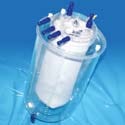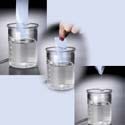November 18, 2004
Originally Published MPMN November 2004
PRODUCT UPDATE
Bending, Shaping, and Molding the Future with Plastics
Bioabsorbability, strength, and clarity are key for medical plastics and elastomers
Susan Wallace
T here are several things that medical device OEMs require when choosing plastics and elastomers for the formulation of their products. Toughness, clarity, and resistance against repeated sterilization procedures all play a role in a manufacturer’s selection process. Some product applications also may require a polymer to be biodegradable. Recent uses of bioabsorbable polymers include surface coatings on drug-eluting stents. Implantable devices designed for site-specific drug delivery may also be produced using biodegradable polymers, eliminating the need for surgical removal of the devices. This article explores recent advances in the development and design of plastics and elastomers.
Company Receives Patent for Polymeric Tissue Implants
|
Cyrolite compounds from Cyro Industries are suitable for use in products requiring gamma irradiation, high impact strength, and low melt-flow rates. |
Biodegradability of polymers continues to be a hot topic within the medical device industry. OsteoBiologics Inc. (OBI; San Antonio, TX), a manufacturer of bioabsorbable polymeric materials, recently received a U.S. patent for its fiber-reinforced biodegradable scaffolds. The patent covers methods of manufacturing fiber-reinforced, polymeric implant materials useful for tissue engineering, specifically to facilitate regeneration of load-bearing tissues such as articular cartilage and bone. This new patent broadens existing OBI technologies for both porous and nonporous resorbable scaffolds useful as implants.
Multipolymer Compound Product Line Expands
Cyro Industries (Rockaway, NJ) has expanded its range of Cyrolite acrylic-based multipolymer compounds for global manufacturers of disposable medical devices. The new formulations of transparent Cyrolite compounds are suitable for use in products requiring gamma irradiation, alcohol and lipid resistance, exceptional impact strength, and low melt-flow rates. Applications include luers, spikes, check valves, blood-handling components, catheter accessories, rigid packaging trays, and IV adaptors, connectors, and filter housings.
Water-Soluble Polymers Stay Strong and Clear
Tensile strength and enhanced clarity meet solubility with the development of a water-soluble polymer by A. Schulman Inc. (Akron, OH). AquaSol uses a proprietary polyvinyl alcohol technology for film and injection molding applications. The polymer’s physical properties are similar to blown film, yet when exposed to water, it dissolves in as little as 60 seconds. While previous water-soluble materials have had issues with processing and yellowing of the film, AquaSol is free from these problems, according to business manager Oscar Mascarenhas. The polymer is available as a raw material in pellet form in three grades: cold-water formulation, hot-water formulation, and a general-grade formula for any water temperature. Potential uses include packaging for detergents and chemicals, barrier films, graphics films, and disposable medical supplies, as well as injection-molded products.
Thermoplastic Elastomer Is Designed for Comolding and Surface Use
A series of medical grades of a thermoplastic elastomer (TPE) compound developed by VTC France, SAS (La Chabanne, France) offer an alternative to silicone and natural rubber. Mediprene can be molded into medical devices for surface use. TPE materials have excellent transparency, making them suitable for use in surface devices. The materials are also flexible, soft to the touch, disposable, and easily sterilized. As with most TPEs, Mediprene may be comolded or coextruded with other polymers.
Getting Clear with Transparent Copolymers
|
The blood filter pictured above was molded using Nova Chemicals’ Zylar 390, an acrylic copolymer that retains clarity even after repeated sterilization processes. |
Nova Chemicals Corp. (Pittsburgh) has introduced Zylar 390, a clear acrylic copolymer with a lower specific gravity and greater color consistency than other transparent copolymers. Reduced drying requirements and machine wear make Zylar suitable for molding applications. The copolymer is an impact-modified resin that does not discolor during sterilization processes such as gamma radiation, EtO, and E-beam. Lower injection pressure, clamp force, and mold and melt temperatures are needed to process Zylar as compared with polycarbonate, according to the company. Zylar can also be extruded in frosted appearance applications.
Resins Offer Lipid Resistance and Gamma Color Stability
Three new resins from GE Advanced Materials have resistance to lipids and color stability. The new Lexan resins include a gamma-stabilized grade that combines resistance to lipids with multiple-cycle autoclave sterilization capability; a gamma-stabilized grade that offers a midrange melt-flow index (MFI); and a clear, high-heat polycarbonate for repeated autoclave use.
The Lexan HPS7 resin is a lipid-resistant polycarbonate that is stabilized for exposure to gamma and E-beam irradiation. It shows no statistically significant change in physical properties after gamma sterilization. This new grade can be used in healthcare applications for the blood-care, surgical support equipment, and fluid-delivery segments. Potential uses include blood dialyzer components, stopcocks, luers, and Y-sites.
|
AquaSol from A. Schulman has properties similar to blown film but will dissolve in as little as 60 seconds when exposed to water. |
Lexan HPS4 resin is a gamma-stabilized material engineered for an MFI of 10, further expanding the flow options for GE’s gamma-resistant portfolio of materials. With the addition of this product, the company now offers gamma-stabilized Lexan resin grades with MFIs of 5, 7, 10, 17.5, and 25, giving processors greater manufacturing flexibility. The HPS4 resin shows no significant change in physical properties after exposure. It is designed to meet certain blood- care, surgical instrument, fluid-delivery, and enclosure and housing application requirements specific to the healthcare industry. Potential applications include blood filters, blood bowls, fluid-connection devices, syringe components, housings requiring sterilization, and surgical instruments.
Last, the Lexan 4404 resin is a clear, high-heat polycarbonate designed for use in devices exposed to multiple autoclave cycles. It is suitable for applications that may be exposed to up to 10 autoclave cycles at 134° C and offers improved dimensional stability over most common polycarbonate resins. Lexan 4404 resin is a potential fit for a variety of surgical instruments and healthcare support equipment, along with certain biopharmaceutical applications in which the use of autoclave sterilization is growing.
Copyright ©2004 Medical Product Manufacturing News
You May Also Like





